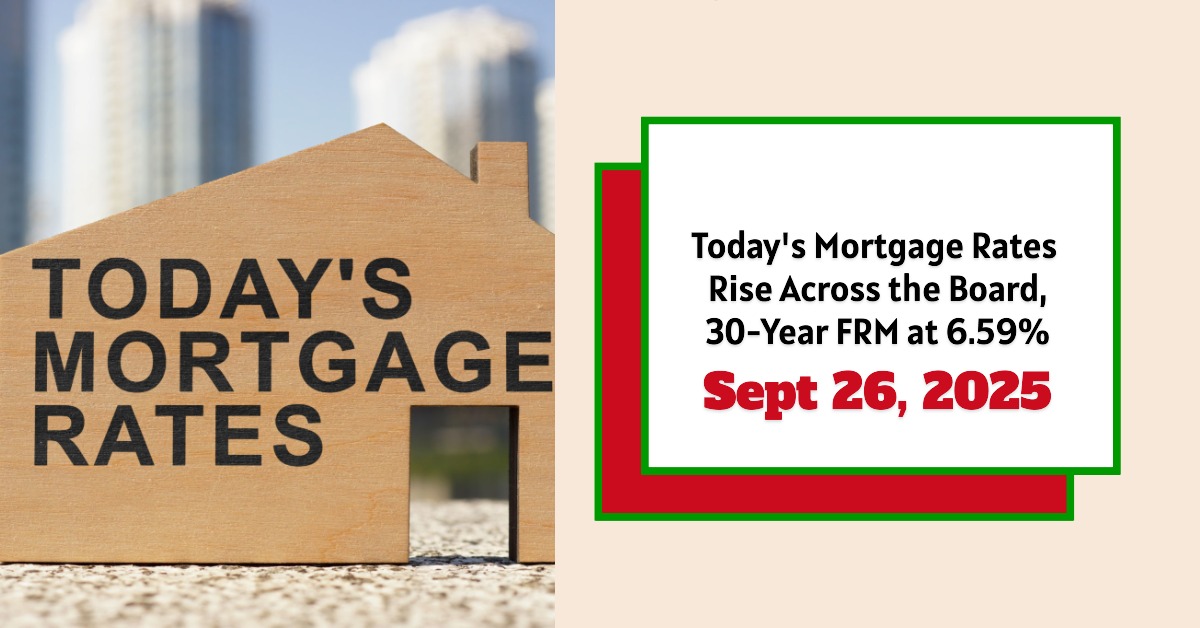Mortgage rates today, September 26, 2025, have increased across the board, with the average 30-year fixed mortgage rate rising to 6.59%, up 12 basis points from last week’s 6.47%, according to Zillow’s latest data. Both mortgage and refinance rates climbed, signaling a modest shift that impacts borrowing costs for homebuyers and homeowners looking to refinance. The 15-year fixed mortgage rate went up slightly to 5.74%, and adjustable-rate mortgage (ARM) products also saw increases. Refinance rates surged as well, with the 30-year fixed refinance rate jumping to 7.12%. These changes reflect the complex interplay between Federal Reserve policies, economic data, and market expectations.
Today's Mortgage Rates – September 26, 2025: Rates Surge Impacting Borrowing Costs
Key Takeaways:
- 30-Year Fixed Mortgage Rate: Increased to 6.59%, up 12 basis points from last week.
- 15-Year Fixed Mortgage Rate: Slightly rose to 5.74%.
- Adjustable-Rate Mortgages: 5-year ARM rate increased to 7.17%.
- Refinance Rates: 30-year fixed refinance jumped to 7.12%, up 36 basis points.
- Federal Reserve Rate Cut: Fed reduced benchmark rate to 4.0%-4.25%; indirect effect on mortgage rates ongoing.
- Outlook: Experts anticipate mortgage rates around 6.4% for the rest of 2025, possibly dipping to 6.1% in 2026, though volatility remains high.
Understanding Today’s Mortgage Rates: A Detailed Snapshot
Mortgage rates dictate the cost of borrowing to buy or refinance a home, so knowing the current rates and trends is crucial for anyone in the market. As of September 26, 2025, mortgage rates in the United States have seen a notable uptick. The primary driver behind recent rate changes is economic uncertainty combined with the Federal Reserve's recent interest rate cut, which set the benchmark rate at 4.00%–4.25%.
Even though the Fed lowered these rates in mid-September 2025 to stimulate economic growth amid signs of slowing employment and persistent inflation, mortgage rates have responded sluggishly. This sluggish response is mainly because mortgage rates closely track the 10-year U.S. Treasury yield, which remains just below its long-term average but has traded in a narrow band lately. The Federal Reserve’s “risk-management” cut aims to prevent economic slowdown without fueling inflationary pressure.
Current Mortgage Rates by Loan Types—Conforming and Government Loans
Here's a detailed comparative table showing the national average mortgage rates today, based on Zillow's reporting:
| Loan Program | Rate % | Weekly Change (%) | APR % | APR Weekly Change (%) |
|---|---|---|---|---|
| 30-Year Fixed (Conforming) | 6.58 | +0.12 | 7.07 | +0.16 |
| 20-Year Fixed (Conforming) | 6.21 | +0.13 | 6.47 | -0.02 |
| 15-Year Fixed (Conforming) | 5.74 | +0.09 | 6.07 | +0.13 |
| 10-Year Fixed (Conforming) | 5.84 | 0.00 | 6.23 | 0.00 |
| 7-Year ARM | 7.18 | +0.04 | 7.67 | -0.24 |
| 5-Year ARM | 7.17 | -0.06 | 7.82 | -0.04 |
| 30-Year Fixed FHA | 7.23 | +1.54 | 8.27 | +1.57 |
| 30-Year Fixed VA | 6.03 | +0.06 | 6.24 | +0.10 |
| 15-Year Fixed FHA | 5.37 | +0.09 | 6.33 | +0.09 |
| 15-Year Fixed VA | 6.06 | +0.38 | 6.42 | +0.46 |
The data shows conforming loan rates are generally lower compared to government-backed FHA and VA loan rates, which also experienced notable weekly increases—especially FHA loans. ARMs remain higher in nominal terms but have seen mixed movement in their weekly changes, indicating market hesitancy around variable-rate products.
Refinance Rates Surge: What It Means for Homeowners
Refinancing allows a homeowner to replace an existing mortgage with a new loan, typically to secure a lower interest rate or better terms. However, refinancing rates have surged recently, resulting in increased borrowing costs for potential refinancers.
| Refinance Loan Type | Rate % | Weekly Change (%) |
|---|---|---|
| 30-Year Fixed Refinance | 7.12 | +0.07 |
| 15-Year Fixed Refinance | 6.01 | +0.18 |
| 5-Year ARM Refinance | 7.45 | +0.03 |
This data implies refinancing is less attractive at present, especially for 30-year fixed refinancing, with rates ticking up over half a percentage point from the previous week. Borrowers with existing mortgages at lower rates might hesitate to refinance unless there’s a compelling reason, such as extracting equity or switching loan terms.
How Do Rate Changes Affect Monthly Payments?
To understand the practical impact of these rate changes, here’s a simple example of a monthly payment difference on a 30-year fixed mortgage:
- Loan Amount: $300,000
- Rate Last Week: 6.47%
- Rate Today: 6.59%
- Loan Term: 30 years
| Rate | Monthly Payment (Principal + Interest) |
|---|---|
| 6.47% | $1,898 |
| 6.59% | $1,918 |
Monthly payment increases by $20 with a 12 basis point rate increase.
Such increases may seem small but add up over the life of the loan, influencing affordability and borrowing decisions.
What’s Driving These Rate Movements? The Federal Reserve’s Role
The Federal Reserve’s recent rate cut on September 17, 2025, reducing the benchmark interest rate to 4.0%-4.25%, aimed to support a softening economy with rising unemployment and persistent inflation concerns. The cut was a “risk-management” move to offset economic risks without overheating inflation.
However, mortgage rates are influenced more directly by the 10-year Treasury yield than by the Fed’s benchmark rate. The Treasury yield, which stood at 4.137% around September 23, 2025, remains slightly below its long-term average of 4.25%, reflecting market uncertainty and cautious optimism.
Still, because mortgage rates incorporate investor expectations about future inflation and economic conditions, we see small fluctuations rather than steep drops immediately following the Fed's cut. The Fed’s “dot plot” projections suggest more measured rate cuts ahead, with expected mortgage rates averaging 6.4% in late 2025 and possibly dipping to around 6.1% in 2026—not a sharp fall but a gradual easing.
Forecast for Mortgage and Refinancing Rates into 2026
Multiple expert forecasts provide a consensus of slowly easing mortgage rates with slight volatility:
- National Association of REALTORS® forecasts mortgage rates to average around 6.4% in the latter half of 2025 and dip further to 6.1% in 2026.
- Fannie Mae's August 2025 forecast expects mortgage rates to end 2025 near 6.5% and drop to 6.1% in 2026.
- Mortgage Bankers Association projects a 30-year mortgage rate of approximately 6.7% by year-end 2025, falling to 6.5% in 2026.
Refinance volumes are expected to rise modestly despite some periods of limited opportunity because of rate volatility.
Related Topics:
Mortgage Rates Trends as of September 25, 2025
Mortgage Rates Predictions Next 90 Days: August to October 2025
Adjustable-Rate Mortgages: What to Expect
Adjustable-rate mortgages (ARMs) tend to reflect short-term interest rate movements more directly than fixed-rate loans because their rates adjust periodically based on a benchmark index tied closely to Federal Reserve actions.
- The 5-year ARM rate slightly decreased by 6 basis points to 7.17% in conforming loans but rose by 3 basis points for refinance ARMs to 7.45%.
- The 7-year ARM increased modestly to 7.18%.
Borrowers with ARMs might see next adjustments align with evolving Fed policies on interest rates, potentially benefiting from lower payments if rates decline further.
How Does This Affect Homebuyers and Sellers?
- Homebuyers: Higher mortgage rates mean higher monthly payments, which can reduce buying power in an already competitive market. Buyers need to carefully budget for increased borrowing costs amid rising home prices.
- Sellers: The slight rise in rates could slow buyer demand marginally but lower rates from recent Fed actions might spur some hesitant buyers. Additionally, rate reductions could encourage homeowners locked into very low pandemic-era rates to sell, potentially increasing inventory.
Capitalize Amid Rising Mortgage Rates
With mortgage rates expected to remain high in 2025, it’s more important than ever to focus on strategic real estate investments that offer stability and passive income.
Norada delivers turnkey rental properties in resilient markets—helping you build steady cash flow and protect your wealth from borrowing cost volatility.
HOT NEW LISTINGS JUST ADDED!
Speak with a seasoned Norada investment counselor today (No Obligation):
(800) 611‑3060
Also Read:
- Will Mortgage Rates Go Down in 2025: Morgan Stanley's Forecast
- Mortgage Rate Predictions 2025 from 4 Leading Housing Experts
- Mortgage Rate Predictions for the Next 3 Years: 2026, 2027, 2028
- 30-Year Fixed Mortgage Rate Forecast for the Next 5 Years
- 15-Year Fixed Mortgage Rate Predictions for Next 5 Years: 2025-2029
- Will Mortgage Rates Ever Be 3% Again in the Future?
- Mortgage Rates Predictions for Next 2 Years
- Mortgage Rate Predictions for Next 5 Years
- Mortgage Rate Predictions: Why 2% and 3% Rates are Out of Reach
- How Lower Mortgage Rates Can Save You Thousands?
- How to Get a Low Mortgage Interest Rate?
- Will Mortgage Rates Ever Be 4% Again?



